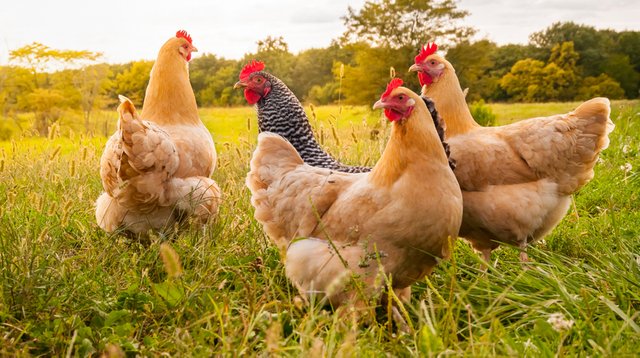Food Journal #10: Hens outdoor breeding, advantages and possible risks
In recent years, outdoor breeding it's back in fashion, especially as a result of the animal welfare increasing awareness, generally neglected by intensive farming in confined spaces. Following the epidemic of bird flu that led to the slaughter of thousands of poultry, however, the consensus towards this form of animal breeding, more similar to natural conditions, seems to have eased. Why?
Today we will investigate the advantages and possible risks caused by the hens outdoor breeding, considering the latest corrections made to the European legislation governing this form of animal breeding.

Advantages and possible risks of outdoor breeding
In short, here are the consequences of raising hens outdoor on a practical level.
Less stress for animals
Confining poultry in too narrow spaces increases the risks associated with overcrowding, such as increasing aggression and the quarrelsomeness of animals, which can cause injury by facilitating the spread of infections. The outdoor breeding, vice versa, drastically decreases these eventualities, improving the wellbeing and general health of the hens, which grow more robust and resistant, both to climatic adversities and diseases. Moreover, as it is easy to understand, air and natural light also benefit the animals, to which hedges and trees are provided to have natural shelter areas, to protect themselves from predators and climatic adversities.

Better nutrition
The possibility of grazing and pecking outdoors makes the nutrition of the poultry richer and more complete, also eliminating the risks of scuffles at the meal time, caused by the hierarchies and the crowding typical of intensive indoor farming.
Parasites and predators
Inevitably, the time spent outdoors exposes more poultry to the attacks of dogs, predatory birds, foxes and other predators. Moreover, even if the health of the animals can improve, the outdoor breeding will favor the contact with wild birds, perhaps attracted by the feeders, possible carriers of diseases and parasites. In areas with cases of bird flu, the excrement of sick wild animals can facilitate the hens contagion.

Hens outdoor breeding in the EU
Before entering into the merits of the advantages and possible risks of the outdoor breeding of laying hens, it is useful to clarify the fundamental aspects according to the European regulations in force, ie the Regulation 589 of 2008, recently modified by the text 2168 of 2017.
According to the community law, the eggs for outdoor breeding must be produced in farms that during the day allow the hens a continuous access to outdoor areas, equipped with areas with vegetation to provide shelter to the animals. Furthermore, the maximum density must never exceed the limit of a hen for four square meters, while the external spaces must not extend beyond a radius of 150 meters from the nearest opening of the building. However, a distance of up to 350 meters is allowed in case there is a sufficient number of shelters - at least four per hectare - homogeneously distributed over the outdoor area.
The 2008 regulation also provided for a derogation period to sell eggs produced in such farms, in cases of limited access to hens outside, following the application of restrictions to protect public health and the animals themselves. After the cases of bird flu in Europe, the Commission has extended this derogation and we will shortly see the highlights of the latest changes.
Latest changes in EU legislation
At the end of last November, the Commission reduced the minimum time to be able to declare "bred outdoor" on the label.
In essence, the mention "bred outdoors" reported on the egg packaging is allowed even if the hens have outdoor access for a period of less than 52 weeks throughout the year. In fact, according to the 2008 regulation, producers could declare the free range even if the animals did not have access to the open space for a maximum of 16 weeks.
The change in the maximum time in closed spaces follows the concerns of European farmers, in relation to the possible economic losses for the breeding hens outdoor. Therefore, the reduction of outdoor breeding aims to limit the possibility of contact with wild migratory birds, recognized as vectors of bird flu disease.
Compared to the previous provisions, therefore, the eggs thus produced should have been sold as coming from hens kept indoors, with obvious economic losses for farmers. The derogation in question also applies to farms and not to entire regions, to allow companies that have introduced new specimens during the restriction to take full advantage of the benefit.

Did you like the post? Please upvote, comment and follow!
AWESOME PHOTOS!
😊
This post has received a 25.00% upvote from @aksdwi thanks to: @foodart.
I was summoned by @foodart. I have done their bidding and now I will vanish...
A portion of the proceeds from your bid was used in support of youarehope and tarc.
Abuse Policy
Rules
How to use Sneaky Ninja
How it works
Victim of grumpycat?
Wonderful photographs! I appreciate the quality of the information, too. This is an important topic to me because care about animal welfare and eat two eggs almost every day. I was not aware of the regulations that allow "free range" to be printed on the packaging. Now I am curious about the regulations here in the U.S. Thanks for sharing this article.
@resteemator is a new bot casting votes for its followers. Follow @resteemator and vote this comment to increase your chance to be voted in the future!
Congratulations! This post was a winner in the weekly #dailyfoodphotography tag contest. Check your wallet for your prize. View the winners blog and Tuesday Top Ten compilation to see your featured photograph. Please consider following the curator's blog and supporting your favorite food photographs. Thank you for participating!